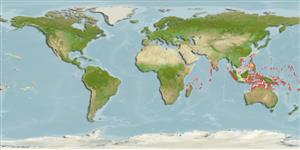Common names from other countries
Environment: milieu / climate zone / depth range / distribution range
Ecologia
marinhas associadas(os) a recifes; intervalo de profundidade 8 - 30 m (Ref. 90102). Tropical; 30°N - 18°S
Indo-Pacific: East Africa to the Society Islands, north to Ryukyu Islands and south to Australia.
Tamanho / Peso / Idade
Maturity: Lm ? range ? - ? cm
Max length : 13.2 cm TL macho/indeterminado; (Ref. 90102)
Espinhos dorsais (total) : 7; Raios dorsais (total) : 12 - 13; Espinhos anais: 3; Raios anais : 9. Body and fins dull yellowish brown; prominent dark ocellus on opercle; dark brown spot on each side of chin (Ref. 4326).
Found on coral heads of lagoon and seaward reefs from 3 to at least 15 m (Ref. 1602). Solitary or in pairs, seldom seen (Ref 90102).
Ciclo de vida ou comportamento de acasalamento
Maturities | Reprodução | Spawnings | Egg(s) | Fecundities | Larvas
Paxton, J.R., D.F. Hoese, G.R. Allen and J.E. Hanley, 1989. Pisces. Petromyzontidae to Carangidae. Zoological Catalogue of Australia, Vol. 7. Australian Government Publishing Service, Canberra, 665 p. (Ref. 7300)
Status na Lista Vermelha da UICN (Ref. 130435)
CITES (Ref. 128078)
Not Evaluated
Ameaça para os humanos
Harmless
Uso pelos humanos
Ferramentas
Relatórios especiais
Baixar XML
Fontes da internet
Estimates based on models
Preferred temperature (Ref.
115969): 26.4 - 28.9, mean 27.9 (based on 198 cells).
Índice de diversidade filogenética (Ref.
82804): PD
50 = 1.0000 [Uniqueness, from 0.5 = low to 2.0 = high].
Bayesian length-weight: a=0.00427 (0.00166 - 0.01096), b=3.17 (2.94 - 3.40), in cm Total Length, based on LWR estimates for this (Sub)family-body shape (Ref.
93245).
Nível Trófico (Ref.
69278): 3.7 ±0.6 se; based on size and trophs of closest relatives
Fishing Vulnerability (Ref.
59153): Low vulnerability (10 of 100).
